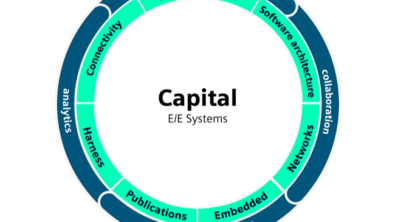AUTOSAR–an introduction

Automotive open system architecture (AUTOSAR) is the leading solution for automotive software platforms. Consequently, the framework enables the efficient development of embedded application software that supports tasks surrounding basic automotive functions in the context of vehicle system development.
What is AUTOSAR?
AUTOSAR is based on the Open Systems and Interfaces for Distributed Electronics in Motor Vehicles (OSEK), a German standard developed in the late 1990s. The AUTOSAR partnership was founded in 2003 as an international standard to enable the corporation on standard software for automotive vehicles. Therefore today, it is the de facto standard for electronic control unit (ECU) platform software. Apart from implementation, AUTOSAR provides a base format on data exchange – the digital thread. It also provides multiple hand- offs between different tools throughout development, so each tool can be used to enrich the data model and provide more granular information.
AUTOSAR Classic vs. AUTOSAR Adaptive
The continuous development of AUTOSAR has made it the preferred design methodology for system-level application design. AUTOSAR provides the ability to:
1. Define the overarching functions and extract scheduling of a task or a runnable in the core.
2. Transport diagnostics data and at the ECU level.
3. Interoperability then both on the bus level between ECU, as well as on the application level
on top of the RT.
Equally important, there are three main parts of AUTOSAR: AUTOSAR Classic Platform, AUTOSAR Adaptive Platform, and
AUTOSAR Foundation. While they may seem to be competing for attention, in reality, they complement
each other.
1. AUTOSAR Classic is designed for the Classic control ECU, which controls legacy features for the vehicle. AUTOSAR Classic has a statically defined function that is updateable through software updates.
2. AUTOSAR Adaptive is used for computation and the fusion of data, and it enables the legacy
POSIX and Linux ECUs such as infotainment clusters and telematics to be described at a function system level, then derived down to the implementation and applications.
3. AUTOSAR Foundation is underneath both of these platforms and contains the foundational requirements. At the present time, these requirements capture the interoperability between the two platforms.
Read more on our website→ What is AUTOSAR?
And when you are ready for the next level, check out these deeper dives!


